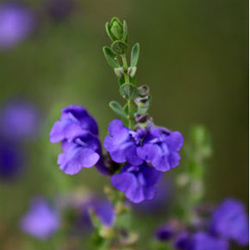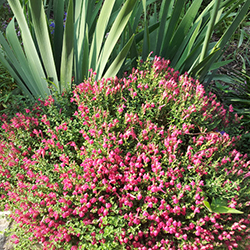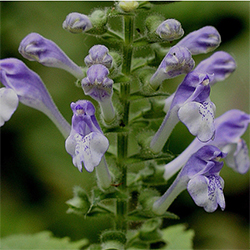Low-growing, low-maintenance and colorful, there are three skullcap species that are just right for your landscape — whether it’s in full sun or partial shade.
Looking for low-growing, low-maintenance, colorful perennial fillers for your landscape? Look no further than your local nursery for these cheerful, well-behaved and drought tolerant perennials.
There are three perennial species that do well in our area. Keep reading to find out which plants are right for your landscape.

Native to the Hill Country, purple skullcap or Wright’s skullcap (Scutellaria wrightii) can be seen growing in and amongst limestone outcrops in full sun to partial shade. This is one of my favorite plants and is a must for rock gardens. Planting in full sun will encourage the numerous tiny, purple blooms and keep your landscape looking peppy during the hottest part of the year.
This gorgeous, native nectar source is generally available in plant nurseries in the full sun, perennial section. Plant with sotol, twist-leaf yucca, aromatic sumac, damianita, little bluestem and blackfoot daisy for a garden that will make you the envy of your neighbors. They’ll be even more envious when they find out that all of these plants require little to no supplemental water to thrive AND very little maintenance.

Pink skullcap, aka Mexican skullcap (Scutellaria frutescens), is sometimes called Texas skullcap. If you’re looking for a tough, pink-flowered, perennial that can take full sun, this is the plant for you! Similar to purple skullcap, pink skullcap performs well in sunny, well-drained locations, but don’t let the common name fool you. Texas skullcap has not been reported as naturally occurring in the state of Texas, but IS a native of Northern Mexico.
On that note, it’s important to look up the Latin name of the plant you’re buying if shopping specifically for native plants. I’ve been to many nurseries where the common name listed on the plant says, “Texas,” when the plant is actually an introduced and sometimes invasive species from another part of the world.
For example, ‘Texas Lilac’ is actually a cultivated variety of Vitex agnus-castus that is native to the Mediterranean. This tree reproduces at a rapid rate and has escaped cultivation in Texas. It now can be found outcompeting native species along the San Antonio River, the once pristine Devil’s River and in streams in the Texas Hill Country. Efforts to restore these ecosystems are very expensive requiring extensive labor, monitoring and follow up treatments with herbicide. Common name labeling of these species is misleading and confusing to gardeners. When planting a garden, it’s imperative to avoid invasive species as they displace native plant communities and disturb wildlife populations.
Heartleaf skullcap (Scutellaria ovata) can be found growing under the shade of oaks and cedar elms in bottomland areas of the Hill Country. This spreading perennial is the perfect solution for filling in shady areas that need a splash of color. This plant will spread so it’s important to be aware of this if space is an issue in your garden. In nature, heartleaf skullcap can be found growing amongst other shade-loving species such as Turk’s cap,inland sea oats, wild ruellia, dwarf palmetto, rusty blackhaw viburnum, blue curls, false marbleseed, pigeonberry and cedar sage. These are all planting combinations that would be suitable in a shady area of your yard in Central Texas.
Thinking of adding some skullcap to your landscape? The SAWS WaterSaver Landscape Coupons available in March can be redeemed for any or all three species mentioned above!





